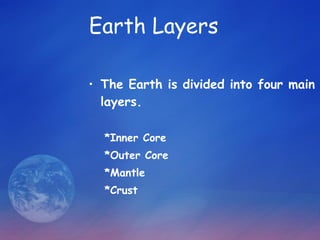Earths Layers
- 1. Earth Layers The Earth is divided into four main layers. *Inner Core *Outer Core *Mantle *Crust
- 2. The Earth’s Crust The crust is the thinnest layer on Earth, 5 km to 100 km There are two types of crust Oceanic crust – made mostly of the igneous rock basalt. Found under the ocean. Relatively thin, 5 km to 7 km. Contains more iron than the Continental crust, therefore is more dense. Continental crust – made mostly of granite. Found under the continents. Relatively thick, up to 100 km.
- 3. Special parts of the Crust Lithosphere Crust is the upper part of the lithosphere. Broken up into large plates. The uppermost part of the mantle is also part of the Lithosphere Asthenosphere Upper part of mantle, below lithosphere 130 – 160 km thick Cooler part of the mantle that the lithosphere plates slide on top of.
- 6. The Earth’s Mantle Located directly above the outer core Starts below the crust Is the largest layer 80% of the Earth’s volume & 68% of Earth’s mass
- 7. The Earth’s Mantle Composed of more iron than the crust. Density, pressure, and temperature all increase the deeper you go in the mantle Temperature ranges from 870 C – 2200 C
- 9. Special layers of the mantle Lithosphere – crust plus the upper, solid part of the mantle. Forms plates. Asthenosphere – just under the lithosphere. Slow moving “Silly putty” layer on which the lithospheric plates slide. (Solid rock that flows very slowly.)
- 11. The Earth’s Core The Earth’s Core Composed of the inner and outer core Both are made of iron and nickel
- 12. The Earth’s Outer Core The Outer Core - Liquid Surrounds the inner core Temperature ranges from 2200 C – 5000 C near inner core Molten (liquid) iron and nickel
- 14. The Earth’s Inner Core The Inner Core - Solid Temperature reaches 5000 C Solid iron and nickel Usually both would be liquid but are solid in the core because of the incredible pressure The solid core is the source of Earth’s magnetic field
- 15. Magnetosphere The inner core and outer cores do not turn at the same speed as the rest of the earth. Causes a generator effect which produces a magnetic field. It protects us from some of the sun’s harmful radiation.
- 17. What does the inside of the Earth look like? How do scientists know that there is a solid inner core?
- 18. Determining the composition of the Earth Scientists cannot see the interior of the planet, or drill to the core, so they use seismic waves to determine the composition of the layers. Seismic waves: are vibrations that are produced when an earthquake happens. Seismic waves travel at different speed depending on the composition and density of material. Measuring these waves tells us what is in the Earth’s layers, and how the materials change.
- 19. i
- 20. What do you know about these layers?
